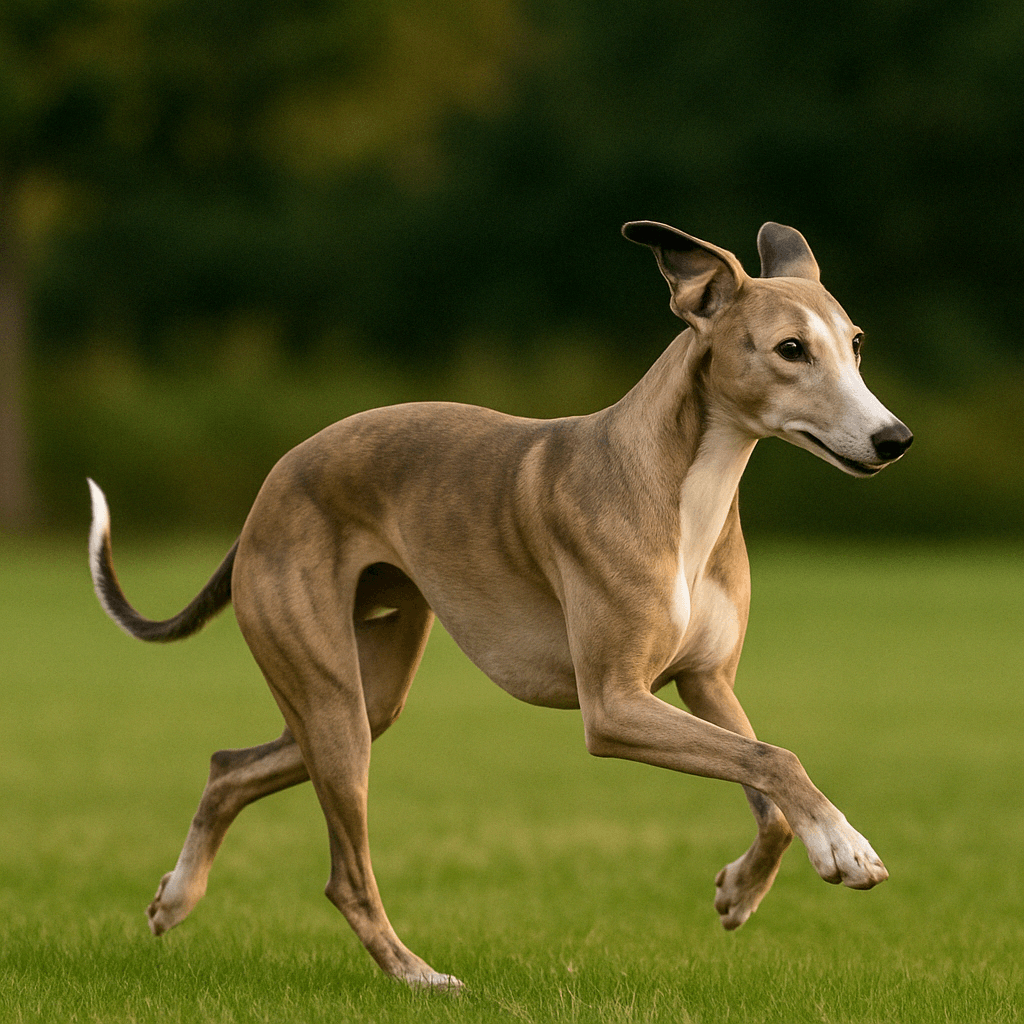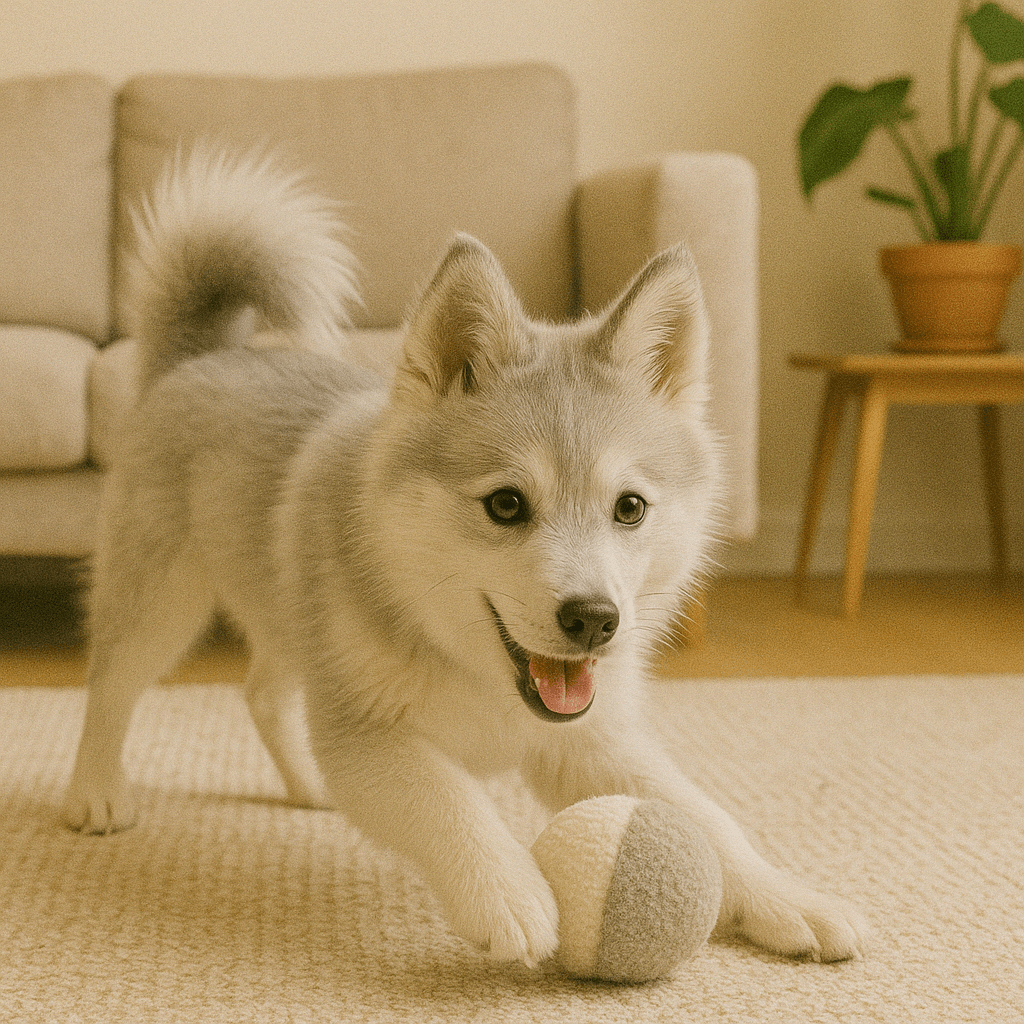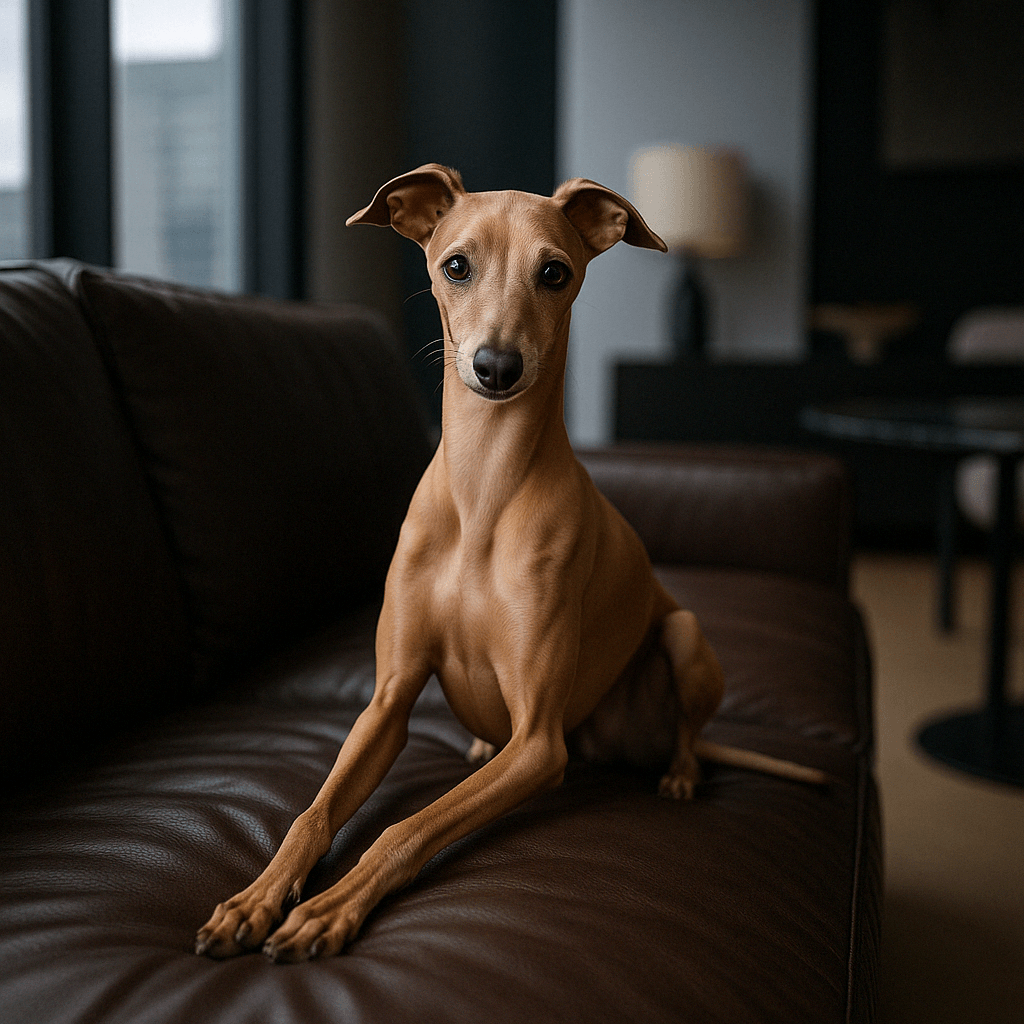
Whippet – Elegance, Calmness and Speed in One Dog
📜 Origin and history of the breed
The Whippet is a breed with fascinating origins, originating in England, where it was developed to be a fast, light, and effective hunting and sporting dog. As early as the 19th century, dogs resembling today's Whippet were used by the British working class, particularly in the industrial areas of northern England—Newcastle, Manchester, and Yorkshire. They were primarily used for hare hunting and track racing, often referred to as "snap dog racing."
To create the ideal compact racing dog, breeders crossed small greyhounds with various terriers (likely the Manchester Terrier) and Italian Greyhounds. The result was a dog that was exceptionally fast, agile, and had a very even temperament.
Official recognition of the breed came in the late 19th century. The Kennel Club in Great Britain approved the Whippet standard in 1891. In the United States, the breed gained popularity in the early 20th century, primarily as a racing dog, and later also as a companion and show dog.
Today, the Whippet is not only an athlete, but also a wonderful family pet, known for its gentleness, elegance and surprisingly friendly nature.
It quickly gained popularity as both a working dog and a companion. Today, Whippets are known for their elegance, gentle nature, and exceptional abilities in track running and lure coursing.
🧠 Character and temperament
The Whippet is the perfect blend of energy and calm. While energetic and avid outdoors, he transforms into a calm, even lazy dog at home, happily spending time on the couch. His temperament can be described as balanced and sensitive – neither dominant nor shy.
It is characterized by:
-
gentleness and attachment to the owner – the Whippet builds a strong bond with people very quickly and feels best close to its family;
-
emotional sensitivity – does not tolerate shouting, chaos and harsh parenting methods well;
-
moderate barking – usually not noisy, but can signal anxiety;
-
high intelligence and obedience – willing to cooperate, especially when approached gently;
-
chasing instinct – a strong drive to chase fast-moving objects, which requires caution when walking;
-
extraordinary empathy – many people believe that whippets are excellent at "reading" the emotions of household members.
This dog is exceptionally calm in a home environment, ideal for apartments, even small ones, as long as it has access to outings and moments of intense activity. It requires tenderness, closeness, and a gentle but firm hand in its upbringing. It doesn't tolerate prolonged loneliness, as it can become apathetic or develop separation anxiety.
A Whippet makes an excellent family dog, but also a companion for singles, seniors, or those working from home. His calm presence is downright therapeutic.
📏 Size and appearance
The Whippet is a dog with an exceptionally harmonious and elegant build, epitomizing lightness and agility. Although small, its body resembles a miniature Greyhound—slender, muscular, and perfectly adapted to high speeds.
-
Height at withers : 44–51 cm (bitches), 47–56 cm (dogs)
-
Weight : 10–15 kg
-
Build : slim, athletic, with a clearly defined waist and long limbs
-
Head : narrow, delicate, with a slender muzzle and a distinct stop
-
Ears : rose, softly folded back, very expressive
-
Eyes : large, oval, full of expression
-
Neck : long, arched, flowing smoothly into the shoulder blades
-
Back : slightly arched, ending in a long, thin tail
-
Coat : very short, smooth and close-fitting
-
Color : comes in all possible colors – solid (black, beige, red, blue), brindle, piebald, with white markings

Its light, aerodynamic silhouette allows it to move with grace and remarkable fluidity. Despite its athletic build, the Whippet is not "stringy"—its lines are soft, and its movement is elegant and graceful. It is also a very photogenic dog, whose appearance often attracts attention on walks and on social media.
The Whippet resembles a miniature greyhound. Its silhouette is the epitome of elegance and aerodynamics.
🩺 Health and the most common problems
Whippets are generally healthy and long-lived (living an average of 12–15 years), but due to their delicate build and low body fat, they require special care in several key areas.
The most common health problems:
-
Mechanical injuries and sprains – due to their thin skin and delicate bone structure, Whippets are more susceptible to abrasions, cuts and injuries, especially when playing intensely with larger dogs;
-
Intolerance to anesthesia – this breed may react more strongly to sedatives and anesthetics; it is worth informing any veterinarian of this before the procedure;
-
Cardiac problems – although rare, congenital heart defects (e.g. cardiomyopathy) may occur;
-
Eye diseases – such as progressive retinal atrophy (PRA), cataracts or corneal dystrophy, which can lead to vision loss or blindness;
-
Teeth and gum problems – improper oral hygiene may lead to inflammation and tooth loss;
-
Low resistance to cold – due to their lack of undercoat and low body weight, the whippet cools down quickly. They should be protected from cold, rain, and moisture with appropriate clothing.
Preventive health care:
-
Regular vet check-ups, including blood tests, echocardiograms and eye examinations;
-
Early vaccinations and deworming;
-
Dietary supplementation (omega-3, glucosamine, vitamin E);
-
Daily dental care and regular oral hygiene check-ups;
-
Moderate physical activity – intense running on uneven terrain should be limited to controlled conditions (e.g. coursing, enclosed runs).
The Whippet is a breed that, with proper care, can enjoy excellent health and activity well into old age. However, a conscious approach by the owner and ongoing observation of the dog are crucial – any sudden changes in behavior or mood should signal a consultation with a veterinarian.
🛁 Care
The Whippet has a short, fine and very close-fitting coat that does not require extensive grooming, but does require regular care due to its lack of undercoat and thin skin.
Hair:
-
Brushing once a week with a soft brush or massage glove improves circulation and removes dead hair;
-
Cleaning with a damp cloth is great for everyday care, especially after walks;
-
Bathe only when necessary – using gentle shampoos for dogs with sensitive skin;
-
In winter and on rainy days : clothing that protects against cold and moisture is mandatory.
Claws:
-
Check every 2-3 weeks and trim if they don't wear down naturally. Nails that are too long can cause walking problems.
In order to:
-
Daily brushing with dog toothpaste or using dental chews;
-
Regular dental check-ups with your veterinarian help avoid inflammation.
Ears and eyes:
-
Ears should be checked regularly and cleaned with a special liquid to prevent infections;
-
Eyes should be washed if discharge appears – preferably with physiological saline.
Thanks to their short coat, the Whippet hardly sheds, making them an ideal dog for people with allergies to fur or those who value a clean home. Their grooming is simple but requires regularity and gentleness—just like the Whippet itself.
🧠 Training and activity
Although quiet at home, the Whippet has enormous potential for physical and mental activity. His heritage as a racing and hunting dog means he needs daily exercise and stimulation. This is a dog that can explode with energy one moment and then fall asleep in a blanket on the couch the next.
Physical activity:
-
Daily walks – at least 2 longer walks a day are essential;
-
Running in the paddock or garden – Whippets need space to stretch their legs and feel the speed;
-
Coursing – running after an artificial lure is one of the most natural forms of exercise for this breed;
-
Frisbee, fetch, ball games – they provide both exercise and exciting interaction with the caregiver;
-
Agility and hoopers – gentle forms of obstacle sports help build bonds and stay fit.
Mental stimulation:
-
Obedience Training – Whippets learn basic commands quickly as long as they are rewarded and treated gently;
-
Logic toys and smell mats – perfect for diversifying your daily routine;
-
Learning tricks – these dogs enjoy challenges, especially when they are creative and dynamic.
Training style:
Whippets don't tolerate pressure or punishment. Positive training, based on rewards, praise, and building relationships, produces the best results. Yelling or forcing obedience can cause them to become stressed and withdrawn.
This sensitive dog responds well to a calm, consistent approach and can be an extremely eager learner. Training sessions should be short, interesting, and varied – this is when the Whippet will reveal its full potential.
Training and activity don't have to be intense – it's important that they are regular and tailored to the dog's individual temperament. A properly cared for Whippet is a happy, fulfilled dog, well-integrated into its owner's daily life.
🏡 Whippet in the family
The Whippet is a dog that thrives in family settings – calm, affectionate, and very attached to its owner. While not pushy, it certainly enjoys being close – both physically and emotionally. It's the perfect companion for those who value peace, ritual, and the warmth of home.
When interacting with children, the Whippet is usually gentle and patient, as long as they respect their boundaries. This is not a dog for intense play and tugging – it prefers quiet company, petting, and relaxing on a shared bed or couch.
He gets along well with other dogs, especially if they're as even-tempered as he is. He can also live with cats, though his chasing instincts may require proper supervision and socialization from puppyhood.
Whippets don't particularly tolerate loneliness – they're a very sociable dog that needs human company. They're ideal for living with someone who works from home, a senior, or a family who can dedicate time to them during the day. Without companionship, they can develop separation anxiety or depression.
They thrive in both a house with a garden and an apartment – provided they have activities and a warm place to rest. They often choose the softest and coziest spots in the house – blankets, sofas, and fluffy pillows. Thermal comfort is key for them.
He loves to sleep under a blanket, cuddle, and be close. He's suitable for apartments—he doesn't need a large garden as long as he has access to daily walks and runs.
🛍 Recommended Petto accessories for Whippets
-
Oi seat – a comfortable and safe way to travel for a slim dog
👉 See the seats -
Osaka bed – soft, well-insulated, ideal for dogs without an undercoat
👉 See the dens
❓ Frequently asked questions (FAQ)
Is a Whippet a good apartment dog?
Yes. Whippets are calm in the home, don't bark excessively, and don't need a lot of space—daily exercise and a soft place to rest are enough for them.
Does Whippet like children?
Yes, as long as children treat the dog with respect and gentleness. Whippets do not tolerate tugging or noisy play.
Does a Whippet shed a lot of hair?
No. This breed has very short fur that sheds virtually non-existent. It's recommended for people who value cleanliness and minimal shedding.
Is a Whippet a good first dog?
Yes, provided the owner is aware of the needs of this sensitive and emotional breed. They are easy to train if gentle methods are used.
Does a Whippet tolerate loneliness well?
No. This is a very sociable dog that becomes very attached to its humans and doesn't handle long periods of separation well. It may suffer from separation anxiety.
Is the Whippet suitable for sports?
Absolutely! Coursing, running, hoopers, and light agility are his thing—provided he's properly prepared and safe.
How long does a Whippet live?
The average lifespan is 12–15 years. With good care, they can live even longer.
🌟 Whippet Trivia
-
🏁 The fastest of small dogs – the Whippet can reach speeds of up to 56 km/h! It's one of the fastest dogs in the world, right after the Greyhound.
-
🛋️ The king of couch potatoes – despite his sporty nature, at home Whippet is a master of relaxation and loves to sleep wrapped in a blanket like a burrito.
-
👃 Delicate skin – the Whippet's skin is extremely thin and sensitive, which is why it is often called the "velvet dog".
-
🌈 A wealth of colors – this breed comes in almost every possible color, making each Whippet unique.
-
🎥 Screen Star – Whippets often appear in films, advertisements, and fashion campaigns thanks to their distinguished appearance.
-
🧣 Hates the cold – Due to their lack of undercoat and thin skin, the Whippet really needs clothes on colder days – it’s not just a style, it’s a necessity!
📌 Summary
The Whippet is a unique breed that combines contrasts: speed and calmness, agility and gentleness, athleticism and a laid-back nature. Although it looks like a miniature racing greyhound, in everyday life it proves to be an incredibly affectionate, sensitive, and devoted companion.
This dog doesn't require vast spaces or extreme exercise—all he needs is a dose of daily activity, human contact, and a safe space to relax. His short coat, low barking, and gentle nature make him an excellent choice, even for apartment living.
The Whippet thrives in families, among the elderly and lonely, as well as among active singles who value contact with a dog without being overly dominant. Well-mannered, they become a loyal friend and discreet everyday companion.
This breed doesn't impose itself, but it easily steals hearts. With proper care, emotional and physical warmth, and matching Petto accessories, the Whippet will not only be a beautiful addition to your home, but also a true family member for years to come.




 https://petto.com.pl
https://petto.com.pl